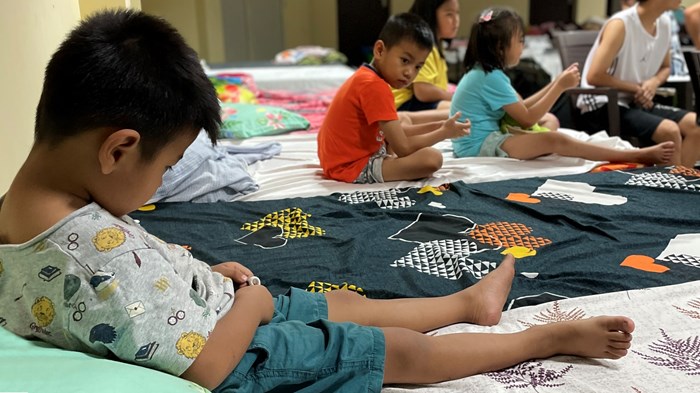
Since the beginning of May, ethnic and religious violence in Manipur, a state in northeast India, has resulted in the deaths of at least 142 people, the destruction of over 300 churches and hundreds of villages, and one of the largest violence-driven internal displacements in recent Indian history. A fact-finding team that visited earlier this month reported that the clashes were “state-sponsored,” and the violence has uprooted more than 65,000 people from their homes and forced them to seek shelter elsewhere.
India records the highest numbers of internal displacements annually, primarily due to natural disasters. But recent communal violence and persecution against religious minorities has wreaked havoc in numerous Indian states, including Gujarat, Madhya Pradesh, and Odisha.
While the government has an official legal framework for helping communities displaced by natural disasters and development projects, it has none for those displaced by violence or manmade conflict. Instead, the level of response has varied widely depending on public sympathy for the victims, media attention, and protests by those affected. Rehabilitation, including the provision of permanent shelter, jobs, and education, remains a significant challenge for the government and the church.
More than two months after the violence began in Manipur, at least 1,000 families are sheltering in Delhi, says L. Kamzamang, a pastor working with internally displaced persons (IDPs) from Manipur.
“Not only are most of the IDPs scattered in various cities and towns in India not wanting to go back to their homes, but young people who are in Manipur are planning to come out of Manipur,” said Kamzamang. “There is nothing to do there. There are no jobs, no source of income. Everything stands still. How will these young people support themselves and their families there?”
A lack of numbers
Regardless of the reason, displacement causes immense and lasting suffering and upheaval for the affected individuals and communities. It can uproot entire populations from places they have called home for up to hundreds of years and destroy livelihoods, social networks, and economic stability.
IDPs and refugees often lose their connection to the land, historical sites, sacred places, and cultural artifacts, all of which hold deep meaning for them. Displacement disrupts the transmission of cultural knowledge, traditions, and languages from one generation to another and can result in the erosion of cultural practices, customs, and beliefs that have been passed down for centuries.
When a community is dispersed and its members are scattered, the collective memory and shared experiences that form the foundation of a cultural identity can be fractured, besides disrupting education, healthcare, and basic services, and exacerbating the vulnerability of those affected. Displaced individuals may also face discrimination, marginalization, and further violence in their search for safety and stability.
India records some of the highest figures for internally displaced persons each year, according to the Internal Displacement Monitoring Centre (IDMC). The country’s large population and socioeconomic vulnerability contributes to the scale of displacement, a situation often provoked by natural disasters.
In the last seven years, an average of over 3 million people per year have been displaced in India. In comparison, fighting in Ukraine has resulted in a total of 1.7 million IDPs between 2014 and 2021.
As for those who have been internally displaced due to violence or conflict, systemic data on those affected is virtually nonexistent due to the absence of a legal framework and the lack of government data. But in 2022 the IDMC recorded 1,000 IDPs primarily resulting from localized incidents of intercommunal (sectarian) violence.
As of late 2022 and prior to the Manipur conflict, approximately 631,000 Indians are still displaced within the country. Many of these communities have been displaced for several decades, including 108,000 people from northeastern India, due to conflicts in northeast states Assam, Mizoram, and Tripura, and 321,000 people from northern states Jammu and Kashmir. Currently, 18 of India’s 28 states are home to IDPs.
A growing terror
Displacement due to religious persecution and conflict in India dates back to the early days of the country. The Partition of India in 1947 changed the political borders that formed India and Pakistan, spurring the killings of more than a million people and causing a massive displacement of at least 20 million. Millions of Muslims migrated from the Indian side to the Pakistan side, while Hindus, Sikhs and others moved towards present day India. Since then, sectarian strife—or communal violence, as it is better known in India—has pushed minorities and underprivileged communities to seek refuge both inside and outside the country.
For years, large-scale religious violence mostly spared Indian Christians, while Muslim minorities were regularly targeted—and continue to be today. Then in the 1990s, those influenced by Hindu extremist ideology, which justifies violence toward religious minorities, began to systematically target Indian Christians.
In 1998 extremists burned down 35 churches between Christmas and New Year’s in the Dang district of Gujarat. Some Christians permanently left the area over this attack, says Jimmy Damore, a Christian leader in Gujarat.
In 2003 and 2004, extremist mobs and leaders associated with Hindu right-wing movements and political parties attacked Christians in the Jhabua and Alirajpur districts of Madhya Pradesh. The government was slow to secure the situation, leaving Christians away from their homes for months.
The worst post-independence violence against Christians in India took place in 2008 in Kandhamal, Odisha, where mobs killed at least 100 people and drove at least 75,000 people from their homes.
Unlike earlier Christian IDPs, a large number of Kandhamal residents did not return—attackers had destroyed their homes. After months in under-resourced and neglected relief camps, many moved to cities where they struggled to find long term, secure employment in other cities in the state.
“Well-settled people with property and homes now had to embrace poverty,” said John Dayal, who led an independent fact-finding team to Kandhamal in January 2008. “Emerging from poverty is not easy; it has to do with long term employment, and not instant charity that may follow violence or a natural disaster. Charity did build some houses [for the victims], but the move out of poverty came for those who could get employment.”
Since the Kandhamal attacks, there have been multiple reports of Christians being threatened, beaten up, socially boycotted, and forced to flee their homes from states like Jharkhand and Madhya Pradesh.
Last year, violence broke out in Chhattisgarh against the tribal Christian community and displaced more than 2,500 people. Fleeing believers left behind animals, crops, and numerous belongings inside their homes, says Akhilesh Edgar, bishop of the Milap Community Episcopal Church and a resident of Chhattisgarh.
“Their homes were looted, animals were stolen, and crops were confiscated,” he said.
Since then, many previously economically stable community members have been forced into “abject poverty,” with little ability to provide for their families beyond seeking out work as daily wage laborers.
“Life for the displaced does not continue to remain the same and is in a way worse than the violence unleashed against them, as they are forced to start from scratch all over again and in a place that is not familiar to them,” said Edgar.
The lack of security and severe loss of property forces victims to make hard choices, says Vijayesh Lal, general secretary of the Evangelical Fellowship of India.
“Most end up in poverty and stare at a future that is uncertain for them and their families. The struggle to survive takes precedence over the struggle for justice,” he said. “There is no time for reflection, for mourning, or even to address the deep-seated mental and emotional trauma that is irreparable.”
The new normal
Generally, India’s state governments, in collaboration with the central government, undertake the rehabilitation of displaced communities through diverse assistance schemes and programs. But because there is no specific law for people displaced due to violence or conflict, there is also no uniformity in the compensation, as Outlook highlighted last year .
Instead, authorities’ responses to victims depend on IDP protests and media coverage of the attacks. Last December, more than 1,500 Christians fled from their homes due to violence in Chhattisgarh. They were forced to spend two days and nights outside in harsh weather conditions in front of a government office in Narayanpur, begging local leaders to provide a safe place for them to shelter. Only after media began highlighting these victims’ plight did the local authorities open an indoor stadium for the IDP community.
However, due to likely pressure from higher-ups and Hindu right-wing groups, within days the government insisted that the Christians return to their villages. Without other housing options, some returned to hostile environments where they continue to face violence, opposition, pressure, social ostracization, and discrimination, and are regularly forced to recant their faith.
On the other hand, according to local leaders, only a fraction of the internally displaced persons in Chhattisgarh have gone back. Others chose to stay in district headquarters or nearby towns where they could periodically check in on their ransacked village homes.
“Everything that I owned has gone, I do not know how we will face tomorrow. We are back in our village, for we could not afford rentals in Narayanpur town, but the villagers have told us that they are waiting for the right opportunity to kick us out of our own home once again,” one visibly disturbed resident, who did not want to give their name for security reasons, told CT.
As Chhattisgarh Christians grapple with this new normal, Edgar remembers that this was not always the case. Religiously-diverse tribal communities have been living together on very good and friendly terms for decades, he points out.
“People in this region have been following the Christian faith for a long time. Some are even third or fourth generation Christians and have lived in peace and harmony for decades with fellow villagers and neighbors. It is only when groups with vested interests and ideology enter the area and mislead the people, only then this violence and atrocities started,” said Edgar. “To initiate peace and to rehabilitate people in their own homes, the government must make sure that the organizations that polarize people are stopped, and that a message of trust and tolerance is spread.”
But for many Christians in Manipur, preventative measures are too late.
Thousands are still living in relief camps or with their relatives or friends in Manipur and in other states. There are reports of armed groups attacking relief camps, raising concerns over the security and safety of those being sheltered there.
Weeks after violence first forced people from their homes, Lal worries about what will happen to this displaced community when the resources run out or another disaster grabs the public’s attention.
“Then Manipur may be forgotten, like Kandhamal has been. But the broken lives of the victims take a long time to mend and heal. The church and NGOs have limited resources and they can only do so much,” said Lal. “The government must compensate the victims whose homes have been lost and lives shattered. Churches must be rebuilt by the government, but will they? Many victims of Kandhamal are still waiting for their just compensation even after nearly 15 years.”

Support Our Work
Subscribe to CT for less than $4.25/month


















